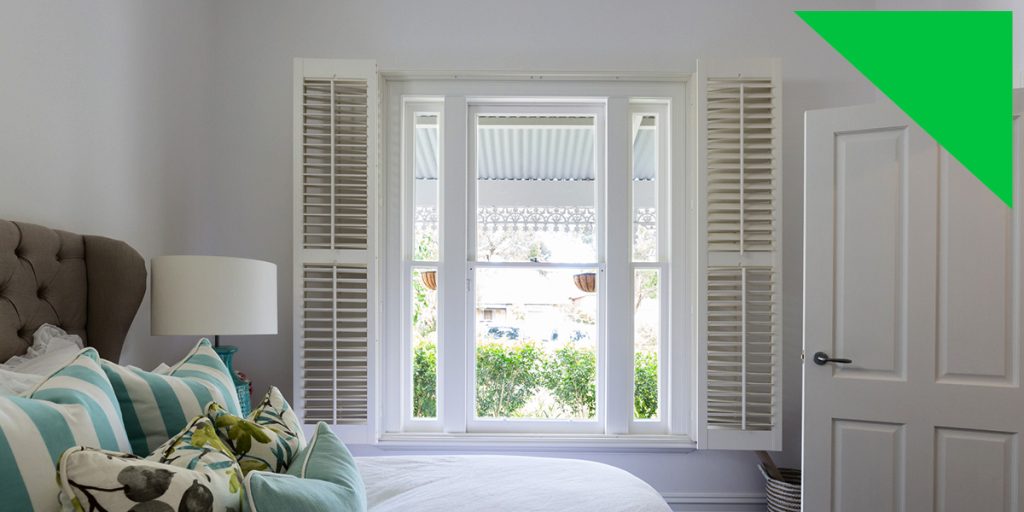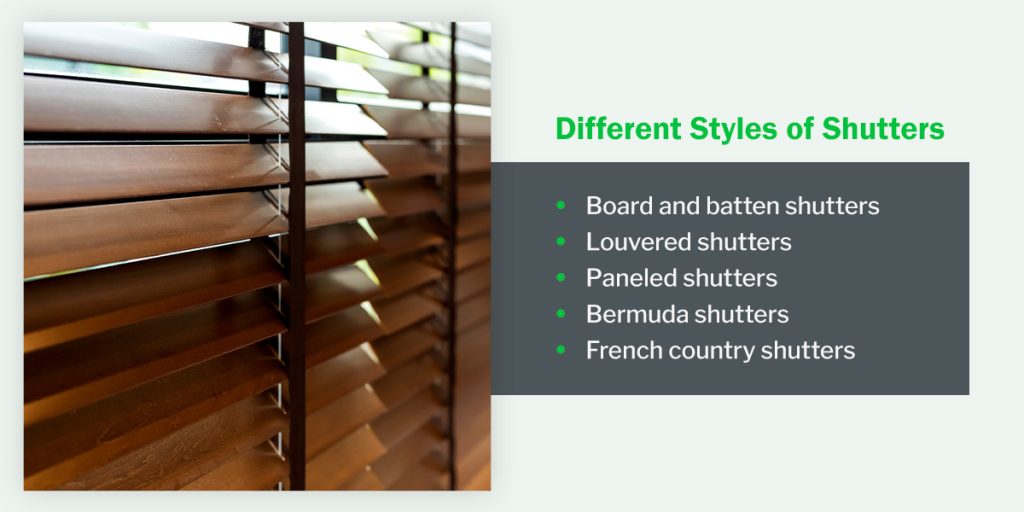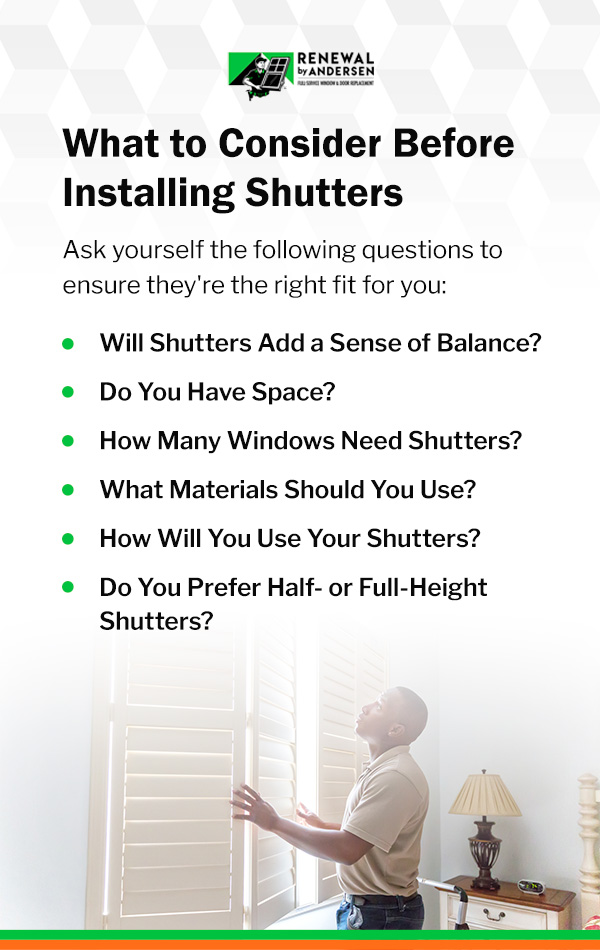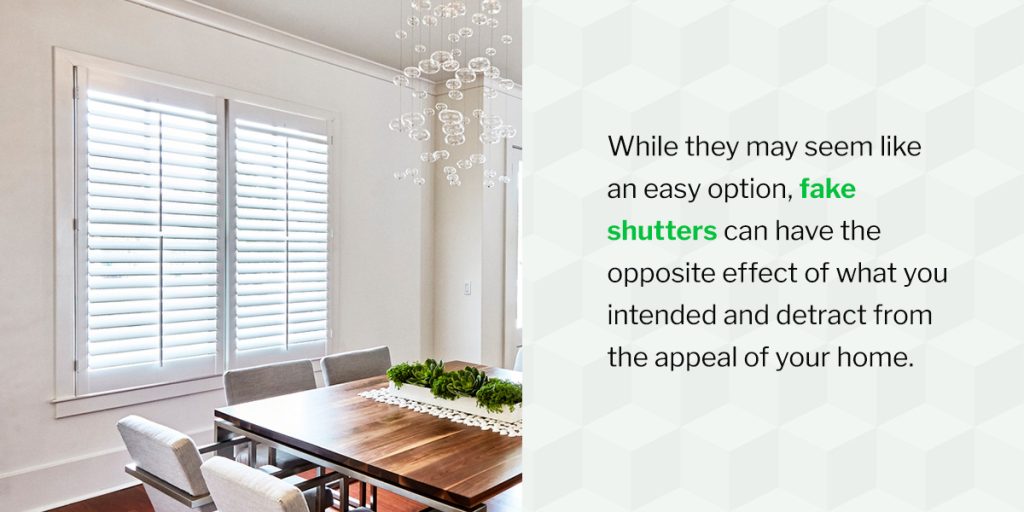MENU


Home upgrades are a fun and worthwhile way to spend your time — you can reinvigorate your home, add value and unleash your creativity. If you’ve considered upgrading your exterior, you may have wondered whether you need shutters to add that finishing touch.
Shutters are far from outdated — the global market size reached $3.4 billion in 2022 and is expected to reach $4.8 billion by 2028. Shutters may not be necessary, but they could still be a worthwhile investment. Under the right circumstances, installing shutters in your home could be just the upgrade you need.
Shutters are solid window coverings made from several materials you can affix to the interior or exterior of your house. Many believe that shutters were first seen in ancient Greece. As they predated electricity and air conditioning, the Greeks used them to manage the ventilation and light in their homes. Shutters have evolved over the years, and many people worldwide choose to have shutters on their windows.
Shutters are still as beautiful and functional today as they were centuries ago. In some cases, even more so. Houses still have shutters for several reasons, including making homes more energy-efficient, protecting windows, elevating the aesthetic appearance of homes and letting in just the right amount of air.
Like blinds and curtains, shutters also provide privacy and security, shielding homeowners from the weather and protecting homes from intruders. Of course, not all houses have them, but whether you need shutters or not, they are still a relevant and appealing addition to many homes.

Shutters come in many variations. Depending on your needs and the style of your home, you can choose from any of the following options:
As long as your shutters match your home’s architecture and period style, there is no reason you shouldn’t mix your shutter styles. Some homes combine styles or have different shutters on every floor. For example, having panels on one floor and louvers on another could be appealing.
Remember, not all windows need shutters, either.
It’s best to understand the pros and cons of shutters before deciding whether to add them to your home. Like any feature, shutters have benefits and drawbacks. Some of the benefits include the following:
There are many benefits to installing shutters in your home, but they aren’t universally suited to every situation. Some of the drawbacks of shutters include the following:

While shutters can be an attractive addition to some homes, they may be out of place in others. Ask yourself the following questions to ensure they’re the right fit for you:
Consider your house’s shape and window size. Sometimes, shutters complete the picture and make your home look more proportionate. Adding shutters can have the opposite effect on other homes, primarily if you’re focusing on one area, like the top or bottom floor. Try and picture your home with shutters and gather whether they’ll create a balanced look.
Installing shutters requires space on either side of your windows. Consider the area alongside your windows and get a professional’s opinion on whether you have enough space to install shutters without trying to squeeze them into a space that needs to be bigger.
No rule says you have to have shutters on every window. Your upstairs windows may be too broad or close together to make shutters possible, but they may be a great addition to the ground floor. Consider all your options — you may only need shutters for some windows.
Shutters come in various materials, each with different properties to suit different uses and environments. Full waterproof materials would be a good choice if you live in a humid climate or one that receives a lot of rain. Hardwood might be best for larger windows. If you plan to operate your shutters often, consider lightweight materials.
Of course, you want your shutters aesthetically pleasing, but they must also be functional. If you plan to keep your shutters closed most of the time, you might benefit from wider panels to adjust the light. For weather protection, paneled shutters could be a more effective choice.
As the name suggests, half-height shutters cover the lower half of windows for increased privacy, especially on windows that face the street. They work well when paired with curtains or blinds, so consider the interior of your home as well.
Shutters make a fantastic addition to many homes. It could be an excellent time to consider adding shutters to your decor if:
If you’re still uncertain, browse online for homes similar to yours and see what others have done to incorporate shutters in a functional and aesthetically pleasing way.
There are occasions when shutters could be challenging. Although no hard and fast rules exist, some houses may have more practical options than shutters. Try and avoid shutters in the following circumstances:

The idea of fake shutters has been a topic of some debate among homeowners. While some prefer the benefits of both form and function in their shutters, others are interested in only the aesthetic appeal. Fake shutters provide the look without the function, which can suit certain homes and personalities.
While they may seem like an easy option, fake shutters can have the opposite effect of what you intended and detract from the appeal of your home. Functional options are best in most circumstances if you’re looking to install shutters.
Once you’ve decided you want shutters, choosing the perfect match for your home is essential. There are several factors to consider to make the right choice.
The wrong shutter size can look unbalanced or fake. Even when your shutters are open, it should be clear that they cover the window when closed. On the other hand, shutters that are too broad or tall can look just as disproportionate. When both shutters are closed, they should be inside the window casing and fill it so they are no gaps in coverage.
If you cut your windows in half, each shutter should be the same shape as these half-windows. If you have arch-shaped windows, the top of your shutters should match this shape to create a seamless look. Avoid curved shutters on straight windows, for example.
When shutters complement the look and feel of your home, they elevate its appearance and create a cohesive look. Imagine having a rustic set of country-style shutters on a modern, minimalist home, and you’ll get the idea. Regardless of your other preferences, your shutters should keep with your home’s period and design.
You can get shutters in various materials, so it’s crucial to balance the aesthetic you’re looking for with an option that suits your lifestyle. Many people love wood for its authentic look and feel, but choosing wood means treating your shutters to ensure they don’t warp or fade. A lower-maintenance option might suit your needs but lacks the feel of wood. Explore all your options and choose one that works best for you.
Just as the shape and style of your shutters must complement your home, so should the color. Many colors exist, but black, white and pastel colors are popular options. Darker colors add elegance, while white and pastels give your home a fresh, simple look. Consider which colors will work best with your exterior.
Shutters can be tricky to install. It’s best to consult a professional and have them come out to do the installation wherever possible. However, knowing the steps involved can help you decide whether to approach the project yourself or hire a professional. These simple steps can give you an idea:
Installing shutters has significant benefits, including increased energy efficiency, privacy and aesthetic appeal. Still, even the best shutters can’t hide that your windows need replacing. Older windows can detract from your overall aesthetic and impact the functionality of your shutters. Why not replace your windows and install your shutters in one go?
The Renewal by Andersen team can help you find replacement windows that suit your needs, ensuring you reap the benefits of your shutters while keeping your home looking fantastic. Our installation process is quick and straightforward, and we can find the perfect replacement windows that last, complement your shutters and save on energy costs.
Contact us to learn more about how we can give your home the face-lift it deserves, or find a showroom near you today!